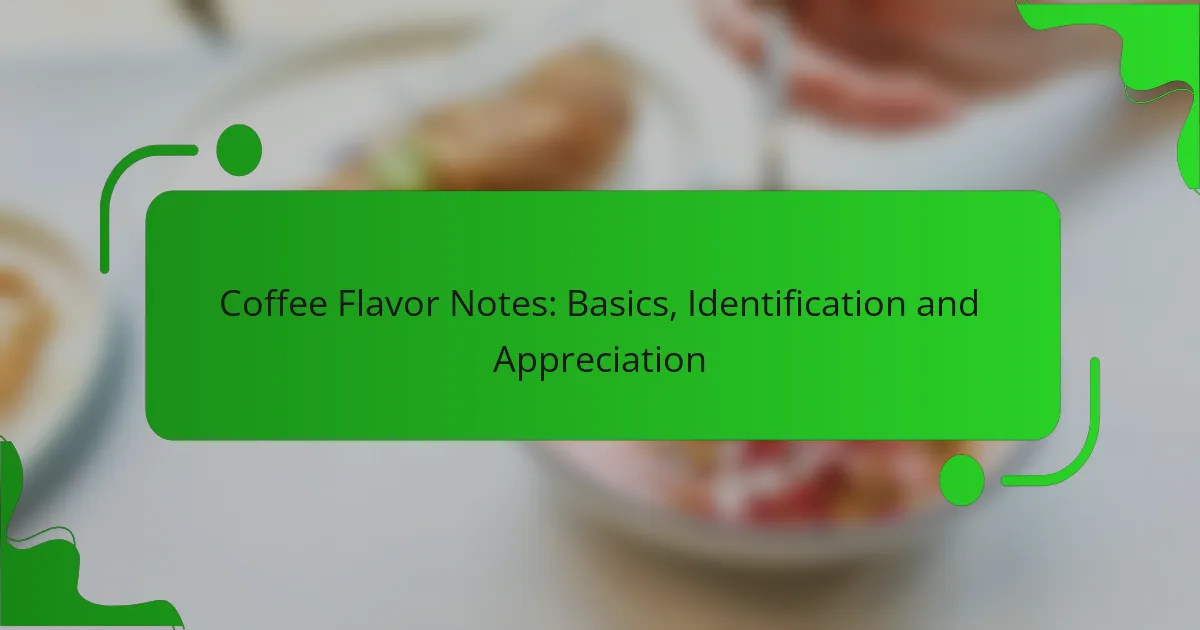Understanding coffee flavor notes is essential for appreciating the diverse tastes and aromas that different brews offer. By exploring the characteristics of various coffee beans and the impact of brewing methods, you can enhance your tasting experience and identify unique flavor profiles. Familiarizing yourself with common flavor notes will deepen your appreciation for this beloved beverage.

How can I identify coffee flavor notes in Los Angeles?
Identifying coffee flavor notes in Los Angeles involves understanding the distinct characteristics of various coffee beans and how they interact with brewing methods. By familiarizing yourself with common flavor profiles and utilizing tasting techniques, you can enhance your coffee appreciation.
Common flavor profiles
Common flavor profiles in coffee include fruity, nutty, chocolatey, and floral notes. Los Angeles coffee shops often feature beans from regions like Central America, Africa, and South America, each contributing unique flavors. For example, Ethiopian coffees may present bright berry notes, while Colombian varieties often have a smooth, caramel-like sweetness.
When exploring flavor profiles, consider the roast level as well. Light roasts tend to highlight the bean’s origin flavors, while dark roasts may emphasize chocolate and smoky notes. This understanding helps you choose coffees that match your taste preferences.
Flavor wheel usage
The flavor wheel is a visual tool that categorizes coffee flavors into distinct groups, making it easier to identify specific notes. Using a flavor wheel can enhance your tasting experience by providing a structured way to articulate what you are experiencing. Look for wheels that include categories such as acidity, sweetness, and body.
To use the flavor wheel effectively, start by sipping your coffee and noting the initial flavors. Then, refer to the wheel to pinpoint similar tastes. This practice can deepen your understanding of coffee and improve your ability to describe what you enjoy.
Tasting techniques
Effective tasting techniques can significantly improve your ability to identify coffee flavor notes. Begin by using the “slurp” method: take a small sip and slurp the coffee to aerate it, allowing the flavors to spread across your palate. This technique helps you discern subtle notes that might otherwise go unnoticed.
Additionally, consider conducting blind tastings with different coffees to challenge your palate. Take notes on each coffee’s flavor profile, aroma, and aftertaste. This practice not only sharpens your identification skills but also enhances your overall appreciation of coffee.

What are the basic flavor notes of coffee?
The basic flavor notes of coffee encompass a range of tastes and aromas that can be identified in different brews. These notes are influenced by factors such as the coffee bean variety, growing conditions, and processing methods, leading to a unique flavor profile for each coffee type.
Acidity types
Acidity in coffee refers to the bright, tangy flavors that can enhance the overall taste experience. There are several types of acidity, including citric, malic, and acetic, each contributing distinct flavor characteristics. For example, citric acidity is often found in coffees from Central America, providing a lemon-like brightness, while malic acidity, reminiscent of apples, is common in some African coffees.
When tasting coffee, consider the level of acidity as it can greatly affect the perception of flavor. A well-balanced coffee will have a pleasant acidity that complements its sweetness and body, rather than overwhelming it.
Body characteristics
The body of coffee refers to its weight and texture on the palate, which can range from light to full. A light-bodied coffee feels more delicate and airy, while a full-bodied coffee has a rich, creamy mouthfeel. This characteristic is influenced by factors such as the coffee bean’s origin and the brewing method used.
For instance, espresso typically has a heavier body due to its concentrated brewing process, while pour-over methods often yield a lighter body. When evaluating coffee, pay attention to the body, as it can enhance the overall flavor experience and influence your preference.
Common flavor categories
Coffee flavors can be broadly categorized into several groups, including fruity, floral, nutty, chocolatey, and spicy. Each category offers a unique tasting experience and can be influenced by the coffee’s origin and processing methods. For example, Ethiopian coffees are often noted for their fruity and floral notes, while Brazilian coffees may lean towards nutty and chocolatey flavors.
To appreciate these flavors, try to identify specific notes during tasting. This can be done by focusing on the initial taste, the mid-palate experience, and the aftertaste. Keeping a flavor wheel or tasting notes can help in recognizing and remembering different flavor profiles across various coffees.

How does brewing method affect coffee flavor?
The brewing method significantly influences coffee flavor by altering extraction time, temperature, and pressure. Different techniques highlight various flavor notes, affecting the overall taste experience.
Impact of espresso vs. drip
Espresso and drip coffee differ mainly in extraction time and pressure. Espresso uses high pressure and a short extraction time, resulting in a concentrated flavor with rich crema and pronounced sweetness. In contrast, drip coffee has a longer brewing time, which can lead to a more balanced flavor profile with subtle notes and a lighter body.
When choosing between the two, consider that espresso often emphasizes chocolatey and fruity notes, while drip coffee can highlight floral and nutty characteristics. This can guide your choice based on personal taste preferences.
French press flavor differences
The French press method allows coffee grounds to steep in hot water, leading to a full-bodied brew with robust flavors. This immersion brewing technique extracts oils and fine particles, contributing to a heavier mouthfeel and a richer taste compared to other methods.
Be mindful of steeping time; typically, a four-minute steep is ideal. Over-extraction can result in bitterness, while under-extraction may yield a weak flavor. Adjusting the grind size can also help fine-tune the flavor profile.
Cold brew nuances
Cold brew coffee is made by steeping coarsely ground coffee in cold water for an extended period, usually 12 to 24 hours. This method produces a smooth, less acidic beverage that often emphasizes chocolate and caramel notes, making it a popular choice for those sensitive to acidity.
For optimal results, use a coffee-to-water ratio of about 1:4 to 1:8, depending on your desired strength. Cold brew can be served straight or diluted with water or milk, allowing for versatile flavor experiences.

What are the best coffee beans for flavor exploration?
The best coffee beans for flavor exploration are typically single-origin and specialty varieties, which offer distinct taste profiles based on their growing conditions and processing methods. These beans allow coffee enthusiasts to experience a wide range of flavors, from fruity and floral to nutty and chocolatey.
Single-origin coffees
Single-origin coffees come from a specific region, country, or even a single farm, which contributes to their unique flavor characteristics. When exploring these coffees, consider the altitude, climate, and soil conditions, as these factors significantly influence taste. For instance, Ethiopian coffees are often fruity and floral, while Colombian varieties may present a balanced profile with nutty undertones.
To fully appreciate single-origin coffees, try brewing them using different methods, such as pour-over or French press, to see how the flavors change. Look for tasting notes on the packaging to guide your exploration.
Specialty coffee brands
Specialty coffee brands focus on high-quality beans and often emphasize ethical sourcing and sustainable practices. These brands typically offer a variety of blends and single-origin options, allowing you to explore diverse flavor profiles. Notable specialty brands include Stumptown, Blue Bottle, and Intelligentsia, each known for their unique roasting techniques and flavor offerings.
When selecting specialty coffees, pay attention to the roast date and origin information on the packaging. Freshness is key to experiencing the full range of flavors, so opt for beans roasted within the last few weeks.
Local roasters in Los Angeles
Los Angeles is home to several local roasters that provide excellent opportunities for flavor exploration. Roasters like Go Get ‘Em Tiger, Stumptown, and Caffe Vita offer a variety of single-origin and specialty blends, often showcasing beans from around the world. Visiting these roasters can provide insights into their sourcing and roasting processes.
Consider attending cupping sessions or tasting events hosted by local roasters to deepen your understanding of coffee flavors. Engaging with knowledgeable staff can enhance your appreciation and help you discover new favorites tailored to your palate.

How can I enhance my coffee tasting experience?
To enhance your coffee tasting experience, focus on the environment, the coffee’s characteristics, and your palate. Engaging all your senses will help you appreciate the nuances of different coffee flavors.
Pairing with food
Pairing coffee with food can elevate both the beverage and the meal. For instance, a bright, fruity coffee complements desserts like chocolate cake, while a rich, full-bodied brew pairs well with hearty breakfast dishes.
Consider the flavor profiles of both the coffee and the food. Sweet coffees can balance savory dishes, while acidic coffees can cut through creamy textures. Experiment with different combinations to discover what works best for your palate.
Using tasting notes
Using tasting notes helps you identify and articulate the flavors in your coffee. Familiarize yourself with common flavor descriptors such as fruity, nutty, or floral, which can guide your tasting process.
When tasting, take small sips and let the coffee linger on your palate. Note the initial flavors, the body, and the aftertaste. Keeping a tasting journal can help you track your preferences and improve your tasting skills over time.
Creating a coffee tasting group
Creating a coffee tasting group allows you to share experiences and insights with others. Gather a few friends or fellow coffee enthusiasts and select a variety of coffees to taste together.
Set a regular schedule and choose a theme for each session, such as single-origin coffees or different brewing methods. Discuss your findings and preferences, which can deepen your understanding and appreciation of coffee flavors.

What criteria should I consider when selecting coffee?
When selecting coffee, consider factors such as origin, roast level, flavor profile, and freshness. These criteria will help you identify a coffee that suits your taste preferences and brewing methods.
Origin
The origin of coffee significantly influences its flavor. Different regions produce beans with distinct characteristics; for example, Ethiopian coffees often have fruity and floral notes, while Colombian beans are known for their balanced acidity and nutty flavors.
When choosing coffee, look for beans labeled with their country of origin. This can guide you toward specific flavor profiles that align with your preferences. Experimenting with beans from various regions can enhance your appreciation of coffee’s diversity.
Roast Level
Roast level affects the taste and aroma of coffee. Light roasts tend to highlight the bean’s natural flavors, while dark roasts often present a bolder, more robust profile. Medium roasts strike a balance between the two.
To select the right roast, consider how you plan to brew your coffee. For instance, lighter roasts are typically better for pour-over methods, while darker roasts may be preferred for espresso. Always check the roast date to ensure freshness.
Flavor Profile
Understanding flavor profiles is essential for selecting coffee that you will enjoy. Common flavor notes include chocolate, fruit, nuts, and spices. Many coffee bags will describe these flavors, helping you make informed choices.
When tasting coffee, take note of the acidity, body, and sweetness. A coffee with high acidity may taste bright and lively, while a full-bodied coffee may feel heavier on the palate. Use tasting notes to guide your selections based on your flavor preferences.
Freshness
Freshness is crucial for optimal flavor in coffee. Coffee beans begin to lose their flavor shortly after roasting, so look for beans that have been roasted recently, ideally within a few weeks.
To maintain freshness, store your coffee in an airtight container away from light, heat, and moisture. Avoid buying in bulk unless you can consume it quickly, as stale coffee can significantly diminish your brewing experience.



